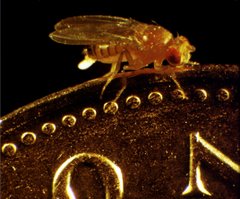Ironically, in the same issue of Science magazine where editor-in-chief Donald Kennedy summarized actions taken by Science to improve its editorial process in the wake of the Korean Human Cloning Scandal, a new scandal has been reported. This time scientists in a Missouri lab allegedly falsified data published in the February 17th issue of Science where they claimed that key cell fate decisions made in the early mouse embryo occur at the very first cell division.
Mah, you may say, so what? So plenty! The determination of anterior-posterior polarity in the embryo is, frankly, what keeps your head out of your ass. Those individuals who choose to realign their body plans later... well that's a personal choice.
The key observation in the February 17th paper was that one of the cells produced in the first cell division of a fertilized mouse egg expresses higher levels of the Cdx2 transcription factor (a class of protein that controls the expression of other proteins) than the other. This initial difference could help explain why certain cells in the mouse embryo are better for generating clones than others.
And now? Not so much. It turns out that the observation that Cdx2 is higher in one mouse cell than the other is fairly easy to fake using Photoshop, or Correl Draw or any of the other common tools embryologists use to prepare their microscopic images for publication. This is not only unrepresentative of the actual data but also tantamount to lying about the results.
Falsification of data is wrong. It's also pretty dumb since the first thing that competing labs do once a paper is published is to try to replicate the results. If they can't get the experiment to work, and they're a hot shot lab themselves, the fraud will be uncovered pretty quickly.
But even if uncovered expeditiously, the cost of fraud is great: in the time of the reviewers, the time of the journal editors, the time of the scientists both perpetrating the fraud and uncovering the fraud. And when you're an academic researcher, the tax payers are footing the bill for all of that time.
So who bears the responsibility for scientific misconduct, as the policy wonks are calling it? With the exception of Woo Suk Hwang's very public denouncement by the global scientific community, it's generally not the lab head, or as they are called on grants, the Principle Investigator (PI). Generally, the blame falls on lower level scientists, often postdoctoral fellows (PhD scientists in an apprenticeship position with the PI) or in some cases the graduate student pursuing a PhD with the PI.
These lower level scientists often carry out the experimentation and are in direct contact with the data. However, a laboratory is led by the PI and there should be some accountability by the management of the lab for transgressions that happen within it. The PI's name is on the grants and is generally the last author on the peer-reviewed publications, and thus should be held accountable.
So why is this not a common practice?
It's no secret that PI's are given little, if any guidance on how to run a lab. Most are thrust from their positions as postdoctoral fellows directly into positions as a lab heads. They receive little mentoring, and no management training as if running a lab were as instinctive as flying south for the winter. Some inroads have been made to this problem, such as the Howard Hughes Medical Institute Guide to Scientific Management and the UC Davis Laboratory Management Institute but management training should become a more mainstream part of scientists career development. (If you think that ANY career development would be an improvement over what they've got now, I'm with ya!)
Perhaps with better management practices in place, including frequent meetings and structured oversight of lower level scientists, misconduct would be less easily hidden from the PI's. And perhaps fewer PI's would suffer from the anterior-posterior realignment to which I referred earlier.
Subscribe to:
Post Comments (Atom)


No comments:
Post a Comment